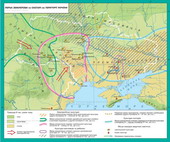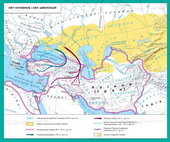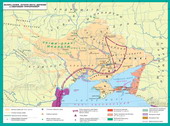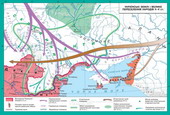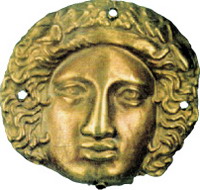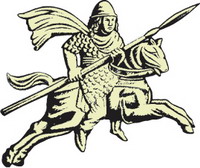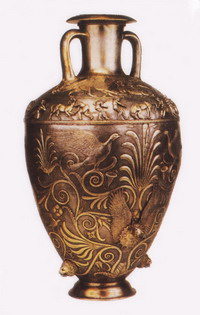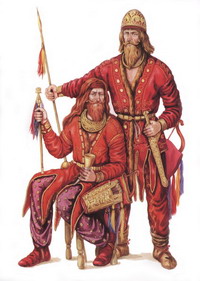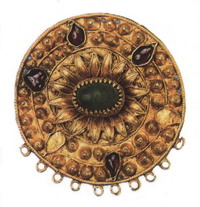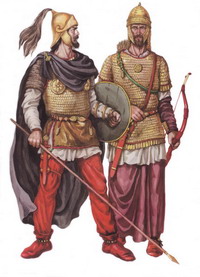§ 58. Religious and spiritual life of the Eastern Slavs
1. Paganism
For many centuries the Slavs formedsystem of religious beliefs, called paganism. Paganism Slavswent a long way of development. First, the basis of religious and mythological paintingsthe world becomes a classic Indo-European model, if the world of gods, society andspace divided into three steps. At each level the gods are placed according to the rulepaired oppositions (contrasts), as opposed to positive (good) god isgod negative (evil).
At the turn of the Niger, some cults formed particular godswhich is a separate and unusual affiliated with other gods. ForMaintenancethese gods appeared separate groups of priests (Magi), who both appeared tobearers of secret knowledge. The most popular were the gods Perun, Veles, Rhode.
Basics of the Slavic pantheon (collectively gods) formed in Slav Bronze Age. Higher nadnebesnyyworld, and headed Svarog Stribog. Bright SvarogConnected with calm, clear, friendly to the people as heaven. Gloomy"God-father" Stribog personified the dark, tumultuous forcewhich could lead to both good and for evil.
At the intermediate level between heaven and earth were already their children whokonkretyzuvaly and implement certain features god-parents. It was Dazhboh,son blue Svarog, and Perun, the god of lightning of thunder, son of the god of dark and sky-highsky Stribog. Dazhboh (translated as "god of sun")was the god of sunlight, heat, fertility in general. He was responsible foragriculture and public policy. Gray-bearded devils advocate Perun-hromovykwent to heaven in a chariot. Following its wheels in the sky is lightening, thunder -then the sound of his chariot, a wheel - then the solar disk. Perun in Slav was the god of warriors. At this level acted as Fire-Svarozhych - Most likely defender artisans. HereThe gods were female Lada and her daughter Lelya. The first was the goddess of marriage,abundance, ripening time of harvest, the second - singles champion girlsgoddess of spring and the first green.
The main figures of the lower, the underworld were Rhode- Holds the earth and all living and Velez - host underworld.Velez was considered the enemy of Perun guide to the souls of the dead otherworldlyworld. To the gods belongs to the underworld, probably Crude Earth Mother - Goddessland, crops, Great Mother of all living. Mokosha were placedAscalled her, was probably his wife and mother Svarog Ladakh.
Pantheon of gods not remained unchanged throughout the history of Slavic. Changesin the economy and social and political life have caused changes in the hierarchygods. Much has changed Velez cult: he became the god of cattle be regarded asand subsequently trade. In ancient times, Slavs often used tocalculations of cattle, and protector of Velez became the merchant class and the guarantor of the treatyrelations. He was also be regarded as a god of harvest, because, as decided Slavsancestors are buried in the ground to protect crops. During harvest time for Velez alwaysleft on the field last sheaf of grain. Of Velezlinked to possession and secret knowledge "volhvuvannya" It was believed thatit - lead souls of the dead in other world.
The emergence of military leaders with their wives and forming the basis for statepower and BC causedwhat were considered the supreme god Perun. That is what is likely to notifyProcopius of Caesarea, writing, and that anti sklavyny "consider that just oneGod - Creator is the master of lightning around the world, and bring him in sacrifice of bulls and all other animals. "
Slavic society more strukturyzuvalosya based on occupation and financial status. Evolved rulingtip, which concentrated in the hands of the right of redistribution producedexcess production.
Tryschableva system changed to a conical (pyramid). The frontPlan pushed god Svarog and gods, which are connected with leading public and industrialfunctions: Dazhboh, Perun, Lada, Fire-Svarozhych,Velez.
Between the gods established family ties. This familyresisted the forces of chaos gods, headed by Chornobohom (OrMiracle).
Next to a cult of leading the gods kept faith with minor changesin gods that are left of pre-Slavic times. Like other nations, oldSlavs believed in life after death, ushanovuvaly spirits of ancestors.
2. Slavic shrine
 The tradition of creating sanctuaries open to the sacrificial bonfires and constructionstone anthropomorphic (humanoid) imagery can be traced to Ukrainianlands since the Indo-Europeans.
The tradition of creating sanctuaries open to the sacrificial bonfires and constructionstone anthropomorphic (humanoid) imagery can be traced to Ukrainianlands since the Indo-Europeans.
Ancient Slavs mostly arranged their sanctuary in the hills andheights with "bald " (Treeless) top. Archaeologicalexcavation allowed to reproduce the appearance of places where Slavs commemorated theirgods. At the top of the hill there were shrines - the place where he stood cap -idol. Temple was surrounded by two earthen ramparts with space between them. Closer tokapischa shaft were areas where rozkladalosya sacred fire. Intervaltwo banks named trebyschemBecause thereshould be carried out - the sacrificial food. Slavs believed that during the holy piru them to join the gods. Accept Peersarranged just like heaven, so in special buildings, palace or temple,located at trebyschi. The second was an external beambelow the sacred place, which was considered desecration and blasphemy was punisheddeath.
In 1908 dvanoslov'yanske sanctuary wasopened in Mount Starokyivska in Kiev archaeologist Vikentiya Chvojka.
3. Zbrutsky idol
Up to now remained very few Slavic gods. Slavs believed inmagical properties of wood and tried to combine it with the power of God.The most interesting among the known is found in 1848 near m.Husyatynain Ternopil on Zbruch river stone called "Zbrutsky Idol ". Now he is in the Krakow archaeologicalmuseums, and a copy is set to St. Sophia Square in Kiev. In place of occurrenceSanctuary was the end of IX - beginning of X century. but researchers believe thatitself is much ancient sculpture.
Zbrutsky idol is a stone sculpture of a column height of 3 m, covered with fourpicture. It probably symbolizes his power to spread allthe four cardinal points. Each side has three-tier idol song picturesappropriate representation of the Slavs of the universe: the sky where the gods live, land -human world and the underworld. In the top tier cap covered with one columnfour images of the gods. The central image of women's cornucopia mightis the goddess of the harvest Mokosha were placed. Left by her god,surrounded by sword at the feet of a jumping horse - probably a Perun. Images on the rightwife of the ring identified with the goddess of marriage Laden. Fourth, menimages associated with Dazhboh. In the middle tier shows men andwomen in the ritual dance. The lower tier represented by one god, that isknees and support the earth, the human world. This image unanimouslyassociated withVelez - God of the afterlife.Located Velez define the front and back of the idol. Idolwas established at the temple on the mountain Bohit overZbruch. Sanctuary existed till the middle of the XIII century. If in connection withMongol invasion of the Magi took off and hid his idol in the river Zbruch.
Questions and Tasks
1. What is the name of the ancient religion of the Slavs?
2. Name the major gods of the Slavic pantheon.
3. What changes have taken place in the beliefs and customs of the Slavs inThroughout the ages? What had caused this change?
4. Where Slavs worshiped their gods?
5. Make a description Zbrutsky idol. What do the images on it?
 English
English


